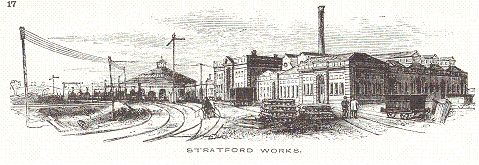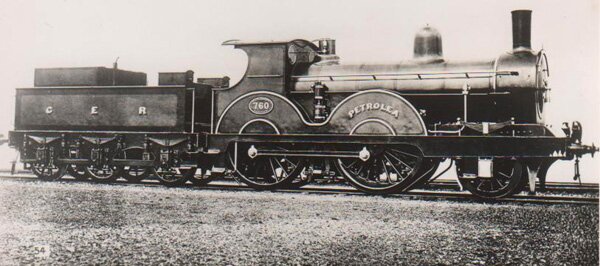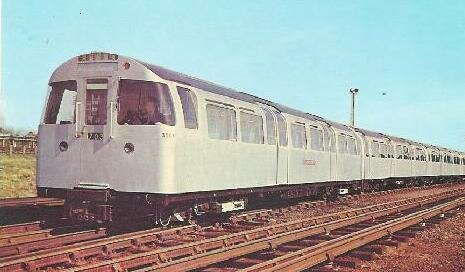Railways
Stratford Works

Built in 1847 by George Hudson, known as the Railway King, Hudson built a complete town around the railway works for his employees, which was then known as Hudsons Town. During the works operating period of 151 years, some 1,682 locomotives were built, along with 5,500 passenger vehicles, and in excess of 33,000 goods wagons. The railway workers of Stratford in 1862 also founded the Stratford Co-operative Society, which later became part of the flourishing London Co-operative Society.
With the coming of the Northern and Eastern Railway to Stratford and Broxbourne in 1840, the Lea Valleys industrial revolution began slowly to move northwards up the valley, providing employment for the region. New housing estates soon followed, such as the huge Warner Estate in Walthamstow, as the valleys population increased dramatically. From 1851 to 1911 the population of the Boroughs of Leyton and Walthamstow alone at the southern end of the valley had both each increased by 120,000.

Stratford works in east London became the home of several notable engineers and superintendents, who were responsible for the introduction of many new ideas and much technical innovation. It was also a works for over 151 years which is a world record. One such superintendent was James Holden, who is noted for his construction of the worlds most powerful steam locomotive, the 0-10-0 Decapod, and the first British oil-fired steam locomotive, called Petrolea.
Over the years the rivalry between railway companies has always been competitive, with each company trying to be better than the other, and in 1888 one of Stratfords rival works, Crewe, of the London and North-Western Railway, built an 0-6-0 locomotive in twenty-five and a half-hours, which was then a British record. Not to be outdone, the challenge was taken up by Holden, and in December 1891, the time for the construction of an 0-6-0 locomotive was reduced to nine hours and forty-seven minutes, which is still a world record today. Not only did he reduce the time of construction, but also gave the engine a coat of grey paint, and sent it straight into regular service. Whats even more remarkable is that the locomotive covered some 36,000 miles before returning for another coat of paint and a service. Following 43 years of service, and covering 1,127,750 miles, regrettably the locomotive was scrapped in 1935. Sadly, today, nothing is left of the works built in 1847 by the railway entrepreneur George Hudson. The original station and town that he also created have all but disappeared with the construction of a modern new station, and the 2012 Olympic site.

Underground
The Victoria line
The first deep-level Underground line to be built across central London since the "tube boom" of 1905-1907, links Walthamstow in north east London with Brixton in south London.
The line opened in stages between 1968 and 1971 penetrating areas of north and south London not previously served by the Underground and designed to ease congestion in the north-east to West End corridor.
The line's origins can be traced back to the Second World War when it was included in the 1943 County of London Plan.
The constraints of the war years and the subsequent re-organisation and nationalisation of London's transport caused the plan to be postponed, and Parliamentary Powers to build the line were not obtained until 1955. Further delays in obtaining funds meant that actual construction work did not start until 1962.
The most important feature of the line is automatic train control system. A driver who has only to push a button to start the train at each station. The train has also been referred to as the driverless train. Many people having been confused with exactly what that meant would not ride on the train. The opening of the Victoria Line to Walthamstow in 1968 resulted in the demise of the No. 38 Bus route from Victoria to Chingford.

Trams
The First British Battery Tram
In 1882 the first known example of electric street traction (tram) was built at the North Metropolitan Union Road works at Leytonstone. The vehicle was a converted horse tram with batteries situated under its seats. The Faure accumulator car, as it was known, was designed by a Mr Radcliffe Ward for the Faure Accumulator Company.




 Built in 1847 by George Hudson, known as the Railway King, Hudson built a complete town around the railway works for his employees, which was then known as Hudsons Town. During the works operating period of 151 years, some 1,682 locomotives were built, along with 5,500 passenger vehicles, and in excess of 33,000 goods wagons. The railway workers of Stratford in 1862 also founded the Stratford Co-operative Society, which later became part of the flourishing London Co-operative Society.
Built in 1847 by George Hudson, known as the Railway King, Hudson built a complete town around the railway works for his employees, which was then known as Hudsons Town. During the works operating period of 151 years, some 1,682 locomotives were built, along with 5,500 passenger vehicles, and in excess of 33,000 goods wagons. The railway workers of Stratford in 1862 also founded the Stratford Co-operative Society, which later became part of the flourishing London Co-operative Society. Stratford works in east London became the home of several notable engineers and superintendents, who were responsible for the introduction of many new ideas and much technical innovation. It was also a works for over 151 years which is a world record. One such superintendent was James Holden, who is noted for his construction of the worlds most powerful steam locomotive, the 0-10-0 Decapod, and the first British oil-fired steam locomotive, called Petrolea.
Stratford works in east London became the home of several notable engineers and superintendents, who were responsible for the introduction of many new ideas and much technical innovation. It was also a works for over 151 years which is a world record. One such superintendent was James Holden, who is noted for his construction of the worlds most powerful steam locomotive, the 0-10-0 Decapod, and the first British oil-fired steam locomotive, called Petrolea.